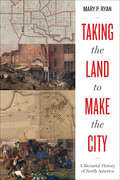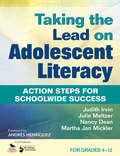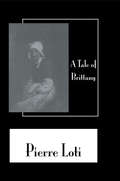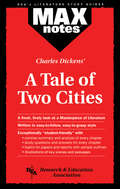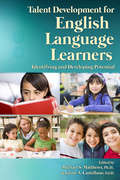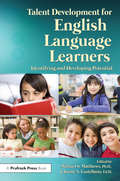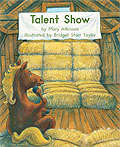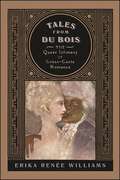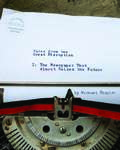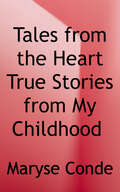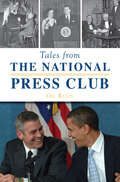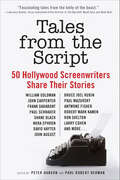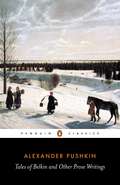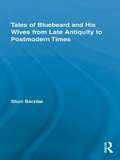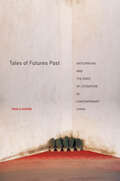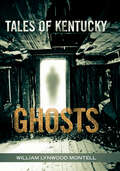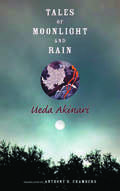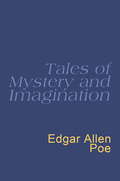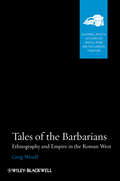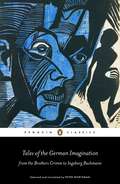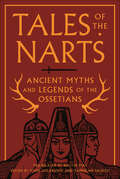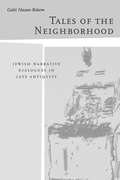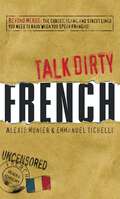- Table View
- List View
Taking the Land to Make the City: A Bicoastal History of North America (Lateral Exchanges: Architecture, Urban Development, and Transnational Practices)
by Mary P. RyanThis historical study shows how San Francisco and Baltimore were central to American expansion through the eighteenth and nineteenth centuries. The history of the United States is often told as a movement westward, beginning at the Atlantic coast and following farmers across the continent. But early settlements and towns sprung up along the Pacific as well as the Atlantic, as Spaniards and Englishmen took Indian land and converted it into private property. In this ambitious study of historical geography and urban development, Mary P. Ryan reframes the story of American expansion. Baltimore and San Francisco share common roots as early coastal trading centers immersed in the international circulation of goods and ideas. Ryan traces their beginnings back to the first human habitation of each area, showing how the juggernaut toward capitalism and nation-building could not commence until Europeans had taken the land for city building. She then recounts how Mexican ayuntamientos and Anglo-American city councils pioneered a prescient form of municipal sovereignty that served as both a crucible for democracy and a handmaid of capitalism. Moving into the nineteenth century, Ryan shows how the citizens of Baltimore and San Francisco molded the shape of the modern city: the gridded downtown, rudimentary streetcar suburbs, and outlying great parks. This history culminates in the era of the Civil War when the economic engines of cities helped forge the East and the West into one nation.
Taking the Lead on Adolescent Literacy: Action Steps for Schoolwide Success
by Judith Irvin Nancy Dean Julie Meltzer Martha Jan Mickler"This rich resource walks middle and high school literacy leaders through a comprehensive process for conceptualizing, initiating, and, most important, sustaining a schoolwide literacy learning program. The authors clearly know teachers and schools, and their reality-tested tools will prove invaluable in guiding and supporting middle and high school literacy leaders."—Doug BuehlAuthor, Classroom Strategies for Interactive LearningA systemic and sustainable approach for improving adolescent literacy and learning!Taking the Lead on Adolescent Literacy provides educational leaders with a user-friendly and comprehensive planning process for developing a new literacy initiative—or for dramatically enhancing a current plan--that has the power not only to raise student performance levels but also to positively impact graduation rates, employability, and higher education success.Using a five-stage framework that has been field-tested nationwide for more than a decade, the authors provide an array of resources to guide in-depth planning, implementation, and monitoring to ensure sustained results, supported by examples from literacy-rich schools, checklists and assessments, and a glossary of terms. Each stage in the process builds upon a school or district′s existing capacities and focuses on six detailed rubrics that can be implemented at every stage to help ensure long-term success:Student motivation and engagement Literacy across the content areas Literacy interventions Literacy-rich environment, policies, and culture Parent and community involvement District support of school-based effortsHelping educators build the critical skills in students for communicating and making meaning within an increasingly complex world, this book shows how a sustained focus on literacy can serve as a powerful lever for school improvement.
Tale Of Brittany
by LotiFirst Published in 2002. Routledge is an imprint of Taylor & Francis, an informa company.
Tale of Two Cities, A (MAXnotes Literature Guides)
by Jeffrey KarnickyREA's MAXnotes for Charles Dickens' A Tale of Two Cities MAXnotes offer a fresh look at masterpieces of literature, presented in a lively and interesting fashion. Written by literary experts who currently teach the subject, MAXnotes will enhance your understanding and enjoyment of the work. MAXnotes are designed to stimulate independent thought about the literary work by raising various issues and thought-provoking ideas and questions. MAXnotes cover the essentials of what one should know about each work, including an overall summary, character lists, an explanation and discussion of the plot, the work's historical context, illustrations to convey the mood of the work, and a biography of the author. Each section of the work is individually summarized and analyzed, and has study questions and answers.
Talent Development for English Language Learners
by Michael Matthews Jaime CastellanoTalent Development for English Language Learners offers concrete guidance to teachers, schools, and administrators seeking to maximize the potential of all of their students. Each chapter will focus thematically on an issue relevant to developing the talents and potential of gifted English language learners (ELLs) in inclusive educational settings. Examples are provided of how schools or educators might conventionally conceptualize and handle the issues related to ELLs and what the concerns or unintended negative outcomes are for gifted ELLs. The authors focus on what an "ideal" response might be from the lens of both the gifted education and the language education field, and how collaborative efforts across these perspectives yield effective interventions in schools and related educational settings for students who are both English language learners and highly academically able.
Talent Development for English Language Learners: Identifying and Developing Potential
by Michael S. Matthews Jaime A. CastellanoTalent Development for English Language Learners offers concrete guidance to teachers, schools, and administrators seeking to maximize the potential of all of their students. Each chapter will focus thematically on an issue relevant to developing the talents and potential of gifted English language learners (ELLs) in inclusive educational settings. Examples of how schools or educators might conventionally conceptualize and handle the issues related to ELLs and what the concerns or unintended negative outcomes are for gifted ELLs are provided. The authors focus on what an “ideal” response might be from the lens of both the gifted education and the language education field, and how collaborative efforts across these perspectives yield effective interventions in schools and related educational settings for students who are both English language learners and highly academically able.
Talent Show (Fountas & Pinnell LLI Green #Level E, Lesson 55)
by Mary AtkinsonFountas and Pinnell Leveled Literacy Intervention Green System -- 1st Grade
Tales from Du Bois: The Queer Intimacy of Cross-Caste Romance (SUNY series in Multiethnic Literatures)
by Erika Renée WilliamsTales from Du Bois brings together critical race theory, queer studies, philosophy, and genre theory to offer an illuminating new comprehensive study of W. E. B. Du Bois's fiction from 1903–1928. Erika Renée Williams begins by revisiting Du Bois's tale of being rebuffed by a white female classmate in The Souls of Black Folk, identifying it as a failure of what she calls "cross-caste romance"—a sentimental, conjugal, or erotic relation projected across lines of cultural difference. In Du Bois's text, this failure figures as the cause of double consciousness, the experience of looking at oneself through the eyes of others. Far from being unique to Souls, the trope of cross-caste romance, Williams argues, structures much of Du Bois's literary oeuvre. With it, Du Bois queries romance's capacity to ground nationalism, on the one hand, and to foment queer forms of Afro-Diasporic reclamation and kinship, on the other. Beautifully written and deftly argued, Tales from Du Bois analyzes familiar works like Souls and Dark Princess alongside neglected short fiction to make a case for the value of Du Bois's literary writing and its centrality to his thought more broadly.
Tales from Shakespeare
by Graham HoldernessIn this engaging new book, writer and critic Graham Holderness shows how a classic Shakespeare play can be the source for a modern story, providing a creative 'collision' between the Shakespeare text and contemporary concerns. Using an analogy from particle physics, Holderness tests his methodology through specific examples, structured in four parts: a recreation of performances of Hamlet and Richard II aboard the East India Company ship the Red Dragon in 1607; an imagined encounter between Shakespeare and Ben Jonson writing the King James Bible; the creation of a contemporary folk hero based on Coriolanus and drawing on films such as Skyfall and The Hurt Locker; and an account of the terrorist bombing at a performance of Twelfth Night in Qatar in 2005. These pieces of narrative and drama are interspersed with literary criticism, each using a feature of the original Shakespeare play or its performance to illuminate the extraordinary elasticity of Shakespeare. The 'tales' provoke questions about what we understand to be Shakespeare and not-Shakespeare, making the book of vital interest to students, scholars, and enthusiasts of Shakespeare, literary criticism and creative writing.
Tales from the Great Disruption: The Newspaper That Almost Seized the Future
by Michael ShapiroIn the first of an in-depth narrative series that will illuminate key moments in journalism’s rough evolution in the age of the Internet, Michael Shapiro tells the little known inside story of the San Jose Mercury News, which brilliantly seized the moment yet didn’t know what to do with it, and then, sadly, released its grasp. Shapiro sheds light on the rise and fall of the Mercury's owner, Knight-Ridder, which rose to dizzying business and journalistic heights, only to crash, a victim of the great disruption. Was it inevitable, or were key mistakes made and opportunities missed?
Tales from the Heart: True Stories From My Childhood
by Maryse CondéIn this collection of autobiographical essays, Maryse Conde vividly evokes the relationships and events that gave her childhood meaning: discovering her parents' feelings of alienation; her first crush; a falling out with her best friend; the death of her beloved grandmother; her first encounter with racism. <p><p>These gemlike vignettes capture the spirit of Conde's fiction: haunting, powerful, poignant, and leavened with a streak of humor. Maryse Conde's previous work includes the novels "Windward Heights "and "Desirada," both available from Soho Press.
Tales from the National Press Club
by Gil KleinA behind-the-scenes history of the organization behind the White House Correspondents&’ Dinner—and the news-breakers and newsmakers who&’ve been part of it. Since the beginning of the twentieth century, the National Press Club has been the hub of Washington journalism. Started by reporters as a watering hole for late-night card games, the Club soon attracted not only icons from Edward R. Murrow to Bob Woodward to Helen Thomas, but every US president from Theodore Roosevelt onward, and various newsmakers who shaped American and world history. While adapting to changes in the news media, it continues to stand for the values of journalism and press freedom in the twenty-first century. Now journalist and longtime member Gil Klein tells just a few of the tales that stand out in the history of the Club, which CBS commentator Eric Sevareid once called &“the only hallowed place I know of that&’s absolutely bursting with irreverence.&”
Tales from the Script: 50 Hollywood Screenwriters Share Their Stories
by Peter Hanson and Paul Robert HermanDiscover the secrets of Hollywood storytelling in this fascinating collection, in which fifty screenwriters share the inside scoop about how they surmounted incredible odds to break into the business, how they transformed their ideas into box-office blockbusters, how their words helped launch the careers of major stars, and how they earned accolades and Academy Awards. Entertaining, informative, and sometimes startling, Tales from the Script features exclusive interviews with film's top wordsmiths, including John Carpenter (Halloween), Nora Ephron (Julie & Julia), John August (Charlie and the Chocolate Factory), and David hayter (Watchmen). Read along as:Frank Darabont explains why he sacrificed his salary to preserve the integrity of his hard-hitting adapta-tion of Stephen King's novella The Mist.William Goldman reveals why he's never had any interest in directing movies, despite having won Oscars for writing All the President's Men and Butch Cassidy and the Sundance Kid.Ron Shelton explains why he nearly cut the spectacular speech that helped cement Kevin Costner's stardom in Bull Durham.Josh Friedman describes the bizarre experience of getting hired by Steven Spielberg to adapt H. G. Wells's classic novel War of the Worlds—even though Spielberg hated Friedman's take on the material.Paul Schrader (Taxi Driver) analyzes his legendary relationship with Martin Scorsese.Shane Black (Lethal Weapon) reveals why the unrelenting hype around his multimillion-dollar script sales caused him to retreat from public life for several years.Tales from the Script is a must for movie buffs who savor behind-the-scenes stories—and a master class for all those who dream of writing the Great American Screenplay, taught by those who made that dream come true.
Tales of Belkin and Other Prose Writings
by Alexander PushkinAlexander Pushkin was Russia's first true literary genius. Best known for his poetry, he also wrote sparkling prose that revealed his national culture with elegance and understated humour. Here, his gift for portraying the Russian people is fully revealed. The Tales of Belkin, his first prose masterpiece, presents a series of interlinked stories narrated by a good-hearted Russian squire - among them 'The Shot', in which a duel is revisited after many years, and the grotesque 'The Undertaker'. Elsewhere, works such as the novel-fragment Roslavlev and the Egyptian Nights, the tale of an Italian balladeer seeking an audience in St. Petersberg, demonstrate the wide range of Pushkin's fiction. A Journey to Arzrum, the final piece in this collection, offers an autobiographical account of Pushkin's own experiences in the 1829 war between Russia and Turkey, and remains one of the greatest of all pieces of journalistic adventure writing.
Tales of Bluebeard and His Wives from Late Antiquity to Postmodern Times (Routledge Studies in Folklore and Fairy Tales #1)
by Shuli BarzilaiThis project provides an in-depth study of narratives about Bluebeard and his wives, or narratives with identifiable Bluebeard motifs, and the intertextual and extratextual personal, political, literary, and sociocultural factors that have made the tale a particularly fertile ground for an author’s adaptation of the story. Whereas Charles Dickens, for example, expresses a sympathetic identification with Bluebeard, and a discernable strain of misogyny emerges in his recreation of the tale and recurrent allusions to it, his contemporary, William Makepeace Thackeray, uses the tale as a springboard for his critique of avarice, hypocrisy, pretension, and the subjugation of women in Victorian society.
Tales of Futures Past: Anticipation and the Ends of Literature in Contemporary China
by Paola IoveneMost studies of Chinese literature conflate the category of the future with notions of progress and nation building, and with the utopian visions broadcast by the Maoist and post-Mao developmental state. The future is thus understood as a preconceived endpoint that is propagated, at times even imposed, by a center of power. By contrast, Tales of Futures Past introduces "anticipation"#151;the expectations that permeate life as it unfolds#151;as a lens through which to reexamine the textual, institutional, and experiential aspects of Chinese literary culture from the 1950s to 2011. In doing so, Paola Iovene connects the emergence of new literary genres with changing visions of the future in contemporary China. This book provides a nuanced and dynamic account of the relationship between state discourses, market pressures, and individual writers and texts. It stresses authors' and editors' efforts to redefine what constitutes literature under changing political and economic circumstances. Engaging with questions of translation, temporality, formation of genres, and stylistic change, Iovene mines Chinese science fiction and popular science, puts forward a new interpretation of familiar Chinese avant-garde fiction, and offers close readings of texts that have not yet received any attention in English-language scholarship. Far-ranging in its chronological scope and impressive in its interdisciplinary approach, this book rethinks the legacies of socialism in postsocialist Chinese literary modernity.
Tales of Kentucky Ghosts
by William Lynwood Montell“Vividly re-creates the context of storytelling in Kentucky in times past.” —Margaret Read MacDonald, author of Ten Traditional TellersA good ghost story can make your hair stand on end, your palms sweat, and your heart race. The bone-chilling collection Tales of Kentucky Ghosts presents more than 250 stories that do just that. William Lynwood Montell has assembled an entertaining and diverse array of tales from across the commonwealth that will keep you checking under the bed every night. The first-person accounts in this collection showcase folklore that Montell has drawn from archives, family stories, and oral traditions throughout Kentucky. The stories include that of the ghost bride of Laurel County, who appears each year on the anniversary of her wedding day; the tale of the murdered worker who haunts the Simpson County home of his killer and former employer; the account of the lost mandolin that plays itself in a house in Graves County, and many more. Tales of Kentucky Ghosts brings together a variety of terrifying narratives that not only entertain and frighten but also serve as a unique record of Kentucky’s rich heritage of storytelling.“Lynwood Montell is truly an icon in the field of Kentucky folklore.” —James McCormick and Macy A. Wyatt, authors of Ghosts of the Bluegrass“Lynwood Montell successfully reports on family stories, bizarre creatures, urban legends, classic country ghost tales, strange glowing lights, talking cats and so much more.” —Thomas Freese, author of Ghosts, Spirits, and Angels: True Tales from Kentucky and Beyond“Sure to both entertain and chill its readers while also allowing them to consider their own supernatural heritage.” —Manchester Enterprise
Tales of Moonlight and Rain: A Study And Translation (Translations From The Asian Classics)
by Akinari UedaFirst published in 1776, the nine gothic tales in this collection are Japan's finest and most celebrated examples of the literature of the occult. They subtly merge the world of reason with the realm of the uncanny and exemplify the period's fascination with the strange and the grotesque. They were also the inspiration for Mizoguchi Kenji's brilliant 1953 film Ugetsu. The title Ugetsu monogatari (literally "rain-moon tales") alludes to the belief that mysterious beings appear on cloudy, rainy nights and in mornings with a lingering moon. In "Shiramine," the vengeful ghost of the former emperor Sutoku reassumes the role of king; in "The Chrysanthemum Vow," a faithful revenant fulfills a promise; "The Kibitsu Cauldron" tells a tale of spirit possession; and in "The Carp of My Dreams," a man straddles the boundaries between human and animal and between the waking world and the world of dreams. The remaining stories feature demons, fiends, goblins, strange dreams, and other manifestations beyond all logic and common sense.The eerie beauty of this masterpiece owes to Akinari's masterful combination of words and phrases from Japanese classics with creatures from Chinese and Japanese fiction and lore. Along with The Tale of Genji and The Tales of the Heike, Tales of Moonlight and Rain has become a timeless work of great significance. This new translation, by a noted translator and scholar, skillfully maintains the allure and complexity of Akinari's original prose.
Tales of Mystery and Imagination (Everyman’s Poetry)
by Edgar Allan PoeRepublished in a form suitable for students and general readers alike.
Tales of the Barbarians: Ethnography and Empire in the Roman West (Blackwell-bristol Lectures On Greece, Rome And The Classical Tradition Ser. #1)
by Greg WoolfTales of the Barbarians traces the creation of new mythologies in the wake of Roman expansion westward to the Atlantic, and offers the first application of modern ethnographic theory to ancient material. Investigates the connections between empire and knowledge at the turn of the millennia, and the creation of new histories in the Roman West Explores how ancient geography, local histories and the stories of wandering heroes were woven together by Greek scholars and local experts Offers a fresh perspective by examining passages from ancient writers in a new light
Tales of the German Imagination from the Brothers Grimm to Ingeborg Bachmann
by Various'It was a very momentous day, the day on which I was to be slaughtered' Bringing together tales of melancholy and madness, nightmare and fantasy, this is a new collection of the most haunting German stories from the past 200 years. Ranging from the Romantics of the early nineteenth century to works of contemporary fiction, it includes Hoffmann's hallucinatory portrait of terror and insanity 'The Sandman'; Chamisso's influential black masterpiece 'Peter Schlemiel', where a man barters his own shadow; Kafka's chilling, disturbing satire 'In the Penal Colony'; the Dadaist surrealism of Kurt Schwitters' 'The Onion'; and Bachmann's modern fairy tale 'The Secrets of the Princess of Kagran'. Macabre, dreamlike and expressing deep unconscious fears, these stories are also spiked with unsettling humour, showing stylistic daring as well as giving insight into the darkest recesses of the human condition.Peter Wortsman's powerful translations are accompanied by brief overviews of the lives of each author, and an introduction discussing the notion of 'angst' and the stories' place in the context of German history.Translated, selected and edited with an introduction by Peter Wortsman
Tales of the Narts: Ancient Myths and Legends of the Ossetians
by John Colarusso ; Tamirlan SalbievThe Nart sagas are to the Caucasus what Greek mythology is to Western civilization. Tales of the Narts presents a wide selection of fascinating tales preserved as a living tradition among the peoples of Ossetia in southern Russia, a region where ethnic identities have been maintained for thousands of years in the face of major cultural upheavals.A mythical tribe of tall, nomad warriors, the Narts were courageous, bold, and good-hearted. But they were also capable of cruelty, envy, and forceful measures to settle disputes. In this wonderfully vivid and accessible compilation of stories, colorful and exciting heroes, heroines, villains, and monsters pursue their destinies though a series of peculiar exploits, often with the intervention of ancient gods.The world of the Narts can be as familiar as it is alien, and the tales contain local themes as well as echoes of influence from diverse lands. The ancestors of the Ossetians once roamed freely from eastern Europe to western China, and their myths exhibit striking parallels with ancient Indian, Norse, and Greek myth. The Nart sagas may also have formed a crucial component of the Arthurian cycle.Tales of the Narts further expands the canon of this precious body of lore and demonstrates the passion and values that shaped the lives of the ancient Ossetians.
Tales of the Neighborhood: Jewish Narrative Dialogues in Late Antiquity
by Galit Hasan-RokemHasan-Rokem explores the relationship between literature and 'reality' in Late Antique Jewish culture by way of sacred Rabbinic stories from the Talmud and the Midrash, focusing on specific Hebrew and Aramaic narratives dating between 150 and 500 CE.
Talk Dirty French
by Alexis Munier Emmanuel TichelliCan't quite come up with the right French quip or four-letter word? WithTalk Dirty: French, you'll be able to put your (middle) finger on it. Each entry provides an individual foreign gem, a useful French sentence employing the word, the expression's English counterpart, and its literal translation,comme ?a: Whether you're a native-speaker, world traveler, or just looking to tell off those brash Parisians, these naughty words and risqu? slang will surely give your tongue a French twist. Les couilles:the balls French Expression:Je l'ai avertie-elle ne m'a pas ?coute alors maintenant je m'en bats les couilles. Translation:I warned her-she didn't listen to me so now I'm washing my hands of it. Literal Translation:I warned her-she didn't listen to me so now I'm flapping my balls of it. Alexis Munierrelocated to Europe in her mid-twenties and began teaching English at world-renowned language schools in Russia, Slovenia, and Italy. Now a writer, English teacher, and translator, Munier still finds time to perfect her French slang and swoon from her Swiss husband's flattery now and again. She lives in Lausanne, Switzerland. Emmanuel Tichellihails from a small town in French-speaking Switzerland, a country with four official languages. Growing up in a feisty French/Italian family, he learned the power of persuasive language at a young age. Tichelli argued with his parents in French, he spoke German at school, watched American TV, and hit on every Italian lady he met, in her native tongue. He lives in Lausanne, Switzerland.
